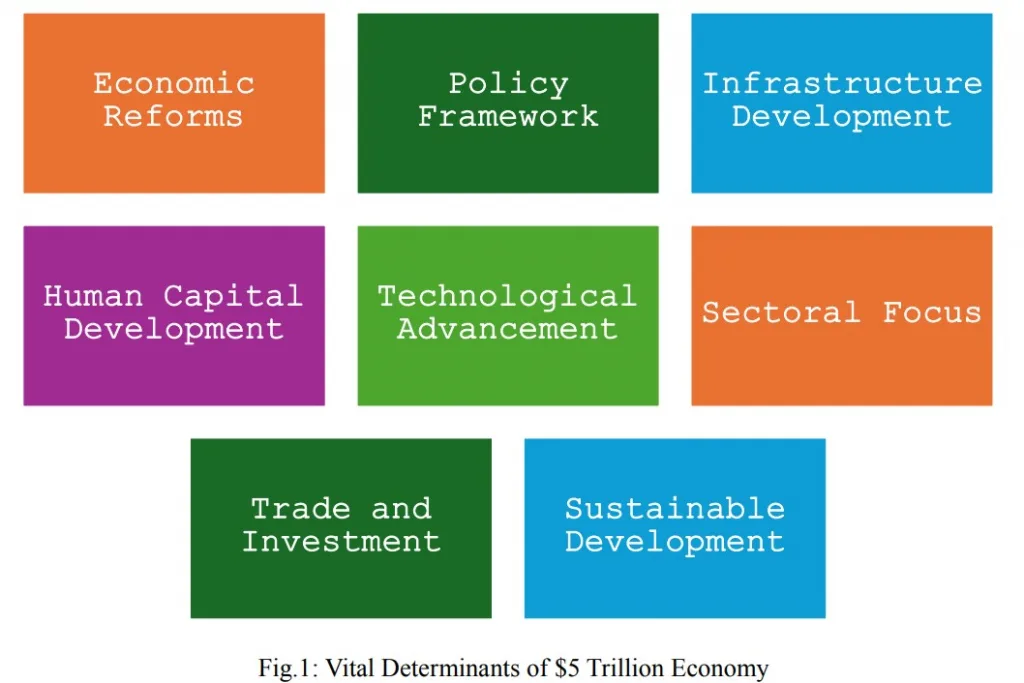Syllabus: GS3/Economy
Context
- Recently, the World Bank, in its report ‘Jobs at Your Doorstep’ has emphasised the critical need for India to adopt a coordinated approach to skills development and employment to achieve its ambitious $5 trillion economy target.
Current Economic Landscape of India
- As of 2024, India’s GDP stands at approximately $3.7 trillion, making it the fifth-largest economy globally.
- The Finance Ministry projects that India will become the third-largest economy with a GDP of $5 trillion by 2027-28.
- This projection is based on continued reforms and the demographic advantage that India enjoys, with a young and dynamic workforce.
Roadmap to $5 Trillion Economy
- Economic Reforms: Major reforms such as the Goods and Services Tax (GST), Insolvency and Bankruptcy Code (IBC), and reduction in corporate tax rates have been implemented to create a conducive business environment.
- Digital Economy and Fintech: Promoting digital transactions and fintech innovations to enhance financial inclusion and efficiency.
- Infrastructure Development: Significant investments in infrastructure, with the Union Budget 2023-24 allocating ₹10 lakh crore for capital investment, representing 3.3% of GDP.
- Energy Transition and Climate Action: Emphasising sustainable development through renewable energy projects and climate action initiatives.
- Employment and Skilling: A robust job market increases consumer spending, which in turn drives demand and stimulates economic activity
- Employment ensures that the benefits of economic growth are distributed across different sections of society, reducing inequality and promoting social stability.
- A well-employed workforce contributes to higher productivity and fosters innovation, which are key drivers of economic competitiveness.

Key Challenges in Achieving $5 Trillion Economy
- Fiscal Deficit: Managing the fiscal deficit while ensuring adequate public investment in critical sectors.
- Employment Generation: Creating sufficient job opportunities to absorb the growing workforce.
- Global Economic Uncertainties: Navigating geopolitical tensions and global economic fluctuations.
- Skills Impartment: Ensuring the quality of training programs is essential to make them effective. This includes having qualified trainers and up-to-date training materials.
- Skilling programs need to be accessible to all, including those in rural and remote areas.
Key Government Initiatives for Achieving a $5 Trillion Economy
- Economic Reforms:
- Goods and Services Tax (GST): The implementation of GST has streamlined the indirect tax system, reducing the complexity and improving compliance.
- Insolvency and Bankruptcy Code (IBC): This reform has strengthened the resolution framework for distressed assets, improving the ease of doing business.
- Corporate Tax Reduction: The reduction in corporate tax rates has made India a more attractive destination for investment.
- Infrastructure Development
- Capital Investment Outlay: The Union Budget 2023-24 allocated ₹10 lakh crore for capital investment, representing 3.3% of GDP. This substantial increase in capital expenditure aims to boost infrastructure development and attract private investment.
- National Infrastructure Pipeline (NIP): This initiative aims to invest ₹111 lakh crore in infrastructure projects by 2025, covering sectors like energy, roads, railways, and urban development.
- Digital Economy and Fintech:
- Digital India: This initiative promotes digital literacy and aims to bridge the digital divide, ensuring that all citizens have access to digital skills and services.
- Fintech Innovations: The government is fostering a conducive environment for fintech startups, enhancing financial inclusion and efficiency.
- Energy Transition and Climate Action:
- Renewable Energy Projects: India is investing heavily in renewable energy, with a target to achieve 450 GW of renewable energy capacity by 2030.
- Climate Action: The government is committed to sustainable development through various climate action initiatives, including the National Action Plan on Climate Change (NAPCC).
- Production Linked Incentive (PLI) Scheme:
- Boosting Manufacturing: The PLI scheme aims to boost domestic manufacturing in key sectors by providing financial incentives for incremental production.
- Sectoral Focus: The scheme covers 14 sectors, including electronics, pharmaceuticals, and automobiles, to enhance India’s manufacturing capabilities and export potential.
- Make in India and Start-up India:
- Make in India: This initiative aims to transform India into a global manufacturing hub by encouraging both multinational and domestic companies to manufacture their products within the country.
- Start-up India: This program supports entrepreneurship by providing funding, mentorship, and regulatory support to startups.
- PM internship scheme 2024: The scheme aims to provide one crore internships in its first five years and enhance employability of candidates.
Key Suggestions
- Bridging the Skills Gap: Aligning education and training with market needs is crucial for addressing the skills gap.
- It ensures that the workforce is equipped with relevant skills that meet industry demands.
- Technological Adaptation: As industries evolve with technological advancements, continuous skilling and up-skilling are necessary to keep the workforce adaptable and competitive.
- Enhancing Employability: Skilling initiatives improve employability, making it easier for individuals to find jobs and for industries to find skilled workers.
- Industry Collaboration: Collaboration between the government and industry is crucial for effective skilling. Industry participation ensures that the skills being imparted are aligned with market needs.
- Initiatives like the Sector Skill Councils (SSCs) and the National Skill Development Corporation (NSDC) facilitate this collaboration.
Conclusion
- The vision of a $5 trillion economy is ambitious but achievable with sustained efforts and strategic planning.
- The government’s focus on structural reforms, digital economy, and infrastructure development lays a strong foundation for this goal.
Previous article
Dark Tourism
Next article
New Moiré Superconductor